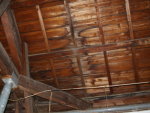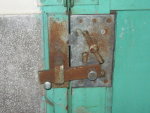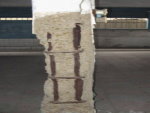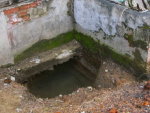Damage
Rolling stones gather no moss – this means that things that are constantly in motion do not tend to break. However, when the Old Chiayi Prison moved to the Lutsao Chiayi Prison, not even the door handles have moved. Everything was still, and the building became more dilapidated, producing a negative cycle, which has increased the dangers of collapse of the prison.
Reasons
Because the factories are Japanese-style, the upper structure is heavy, and then the added covered ridge was thought to be good. However, the covered ridge actually became the primary reason for collapse of the factorywalls. This is because the covered ridge is only on one side of thefactory roof, and its pressure has resulted in cracks on the beams in the center of the roof. Soon later, the roof will also collapse; if there are no protective measures, everything will collapse.
- Roof tiles:

(The wood are wed)
(picture source:Chen Wen-long Architectural Firm)
The functions of roof tiles include drainage, shade, and heat insulation, but the Old Chiayi Prison was constructed under Japanese rule, and has gone through wars and innumerable problems; airstrikes have damaged the tiles which were originally vertically arranged. They were maintained but cracks have begun to appear, so that rainwater does not smoothly flow downwards, but rather flows behind the tiles and into the building. Wood within the buildings were corroded by water and have become bent out of shape. Also because of rain water, moss and mold have begun to grow between the tiles; the whole building is constantly wet.
- Concrete and paint:
(Red brick)
(picture source:photo by this team)
Because it has been too long, these surface materials have begun to peel away. Due to the various effects of erosion, concrete has fallen away, so the exposed brick easily lets in rainwater. Between the paint and the wall, water damage causes further peeling, revealing the rotten wood.
- Metals:

(Metals be rusted)
(picture source:Chen Wen-long Architectural Firm)
Two changes occurred to the door handles, locks, iron doors, and iron railings. First, they became rusted due to too much humidity, so that the locks and handles are stuck and cannot be turned. Second, when emergency paintwork was done on the walls, some engineers were irresponsible and painted over the metal items, so that the metals were now water- and rust-resistant, but these metals have the same color as the walls; this did notlook good. These metals are ancient relics that could be touched and turned by people, but now that it is painted, it is regrettable that people are not able to experience the primitiveness.
Results
- Rainwater:

(Reinforced concrete are uncovered)
(picture source:Chen Wen-long Architectural Firm)
Due to debris of the tiles, water has begun to pour into the building, water has seeped into the wood and concrete. The wood became soft and fragile because it has been soaking water for too long. After pouring into the concrete walls, because water has high specific heat, it expands in response to heat during the day and shrinks in response to the cold during the night; this in turn affects steel beams inside the concrete. During the day, sunlight on the concrete surface (causes expansion), and the steel beams remained at a low temperature due to water (causes shrinkage), and cracks began to form. At night, it was colder outside, so the concrete walls shrank, but the internal steel beams would expand because their temperatures were higher. Cracks became larger, which increased the volume of water flowing in, and exacerbates the heat expansion and cold shrinkage. This affects the metals connected to the wood.
- Damage caused by animals and plants:
Since there was a lot of water in the cracks in the concrete,some plants began to sprout. The roots of these plants absorb water as they continue to dig into the concrete walls;the cracks get deeper and deeper, which cause more accumulation of rainwater, and the wood has become humid and soft, which are then eaten by the termites. Termites have always been difficult to terminate, and they primarily eat wood. After our testing, we havefound the problem. In the ground where termite live,they build nests or and produce formic acid when attacking other organisms; this has changed the earth in which they inhabit. Rain water mixed with pollutants in the air becomes acid rain, which not only makes the ground even more acidic, but has also seeped into the wood, accumulating in the wood and further acidizing it. This poses a great threat to the wood structure of the prison.

(Groundwater)
(picture source:Chen Wen-long Architectural Firm)
- Humidity:
Later it was discovered that water does not only seeps in through the roof. Since the land on which the prison was built on was humid, and there was a high level of ground water, so water vapor continues to seep upward from the ground. The wood build on top of the earth was also seriously eroded by humidity, and capillary action and rainwater. We can continue to conduct further exploration for the ground. If one could stretch one's hand down into the ground, it only took about 40 to 60 cm, or 90 to 120 cm at the deepest to touch groundwater. Groundwater continuously evaporated into the ground, and began to corrode the wood; the termites also increased their scope of activity.
Rainwater caused by reversed roof tiles and vapor rising from the ground have caused cracks in the wood and holes eaten by the termites. These reasons are perhaps the beginning and ending points of the cycle; it is necessary to first slow these problems and then work on other things. However, this is the most difficult point, and it is expected that the tiles will be the first place of renovation. At this time, there are funds to renovate the prison, and there are plans to repair the buildings, to begin in March 2009. There have also been hearings that involved many people. The purpose is to let everyone understand: what kinds of repair work are being done within the prison? What types of protection? What kinds of problems have been encountered?
Sources:
-
Researched and organized by this team
-
Picture source:Chen Wen-long Architectural Firm
-
Old Chiayi Prison local hearing information, November 8, 2008
-
Planning and Research Report on Renovation and Reuse of the Old Chiayi Prison as A Historical Monument of Chiayi City

